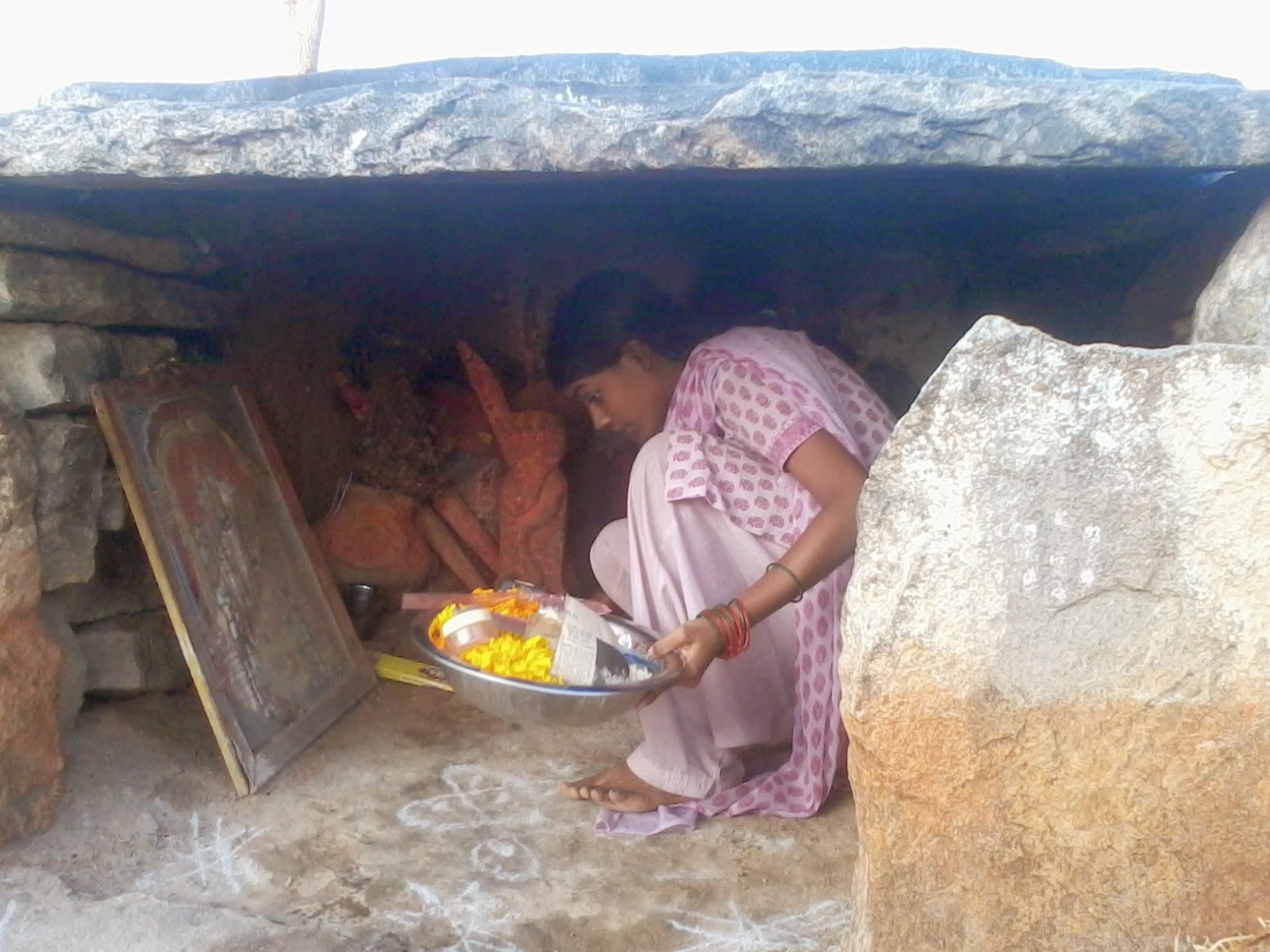 Religion
is an integral part of the lives of the people and interwoven with daily
living. Socializing, community bonding and entertainment are anchored in
religion. Many gods co-exist. A stone is anointed with kumkum, and its divinity
recognized.
Religion
is an integral part of the lives of the people and interwoven with daily
living. Socializing, community bonding and entertainment are anchored in
religion. Many gods co-exist. A stone is anointed with kumkum, and its divinity
recognized. There
is the pantheon of native gods including the mother goddesses like Gangamma.
Some say she belongs to a set of a hundred and one sisters. Lakshmamma said
that there are twelve Gangammas including Tirupathi Gangamma, Pedda Gangamma,
Alavelu Gangamma, Baata (path) Gangamma,
Nadu Veedhi (middle of the road) Gangamma, Katta Meedha (on the bund) Gangamma,
Nalla (black) Gangamma, Banthala
Gangamma, Muthiyalamma (chickenpox Amma), Yerpachchamma, Moolasthanamma, Boyi Gangamma,
Irugalamma and Sibbaalamma. Ganga Bhavani is another goddess, and they say all
are forms of the same goddess. Eashwaramma said, ‘Don’t people have many names,
similarly the Gods.’ Annasamy Anna said, ‘As there are many villages, similarly
there are many gods’.
There
is the pantheon of native gods including the mother goddesses like Gangamma.
Some say she belongs to a set of a hundred and one sisters. Lakshmamma said
that there are twelve Gangammas including Tirupathi Gangamma, Pedda Gangamma,
Alavelu Gangamma, Baata (path) Gangamma,
Nadu Veedhi (middle of the road) Gangamma, Katta Meedha (on the bund) Gangamma,
Nalla (black) Gangamma, Banthala
Gangamma, Muthiyalamma (chickenpox Amma), Yerpachchamma, Moolasthanamma, Boyi Gangamma,
Irugalamma and Sibbaalamma. Ganga Bhavani is another goddess, and they say all
are forms of the same goddess. Eashwaramma said, ‘Don’t people have many names,
similarly the Gods.’ Annasamy Anna said, ‘As there are many villages, similarly
there are many gods’.Trees are worshiped. The neem tree and the peepal tree are married together by the people and the bandhaaram (yellow thread on the neck of married women) and bottu (gold coin on the bandhaaram) are tied on the neem tree. Anthills are worshiped. Snakes are worshiped. There are some huts which have anthills within them and these, considered the abodes of snakes, are never disturbed. Milk and eggs are offered there. The cobra is auspicious.
The Yerpachchamma temple

The
Yerpachchamma temple is on the west of the village and has Yerpachchamma silaas (consecrated
stones), a geriki dutta,
a naagalamma (snake
goddess) silaa, a ganta (bell), a bandaara muguthi (mud lid
for holy ash), jaati naaru (a whip made of kalabandha (Aloe
vera) fibres that the person possessed by the goddess wields) and also has a
soolam planted
outside the low stone shrine, and a soolam planted inside.
Every day the village people take turns for the shrine. In the morning the place is swept, and muggu put. The oil is poured, and the map lit. Lemons are also put on the soolam.
The Sibbalamma temple
This temple is special for the Eddulu families. And daily, in turns, the temple is maintained and the lamp lit.
Once the jewellery of the goddess was stolen, and later replaced with bronze jewels. When the thief was not located, the people decided the goddess would dispense justice as she saw fit.
The Vinayaka temple
 The pride of the village - the Vinayaka temple, built at
subsantial costs and efforts. A one roomed structure houseing the god,
and a big tiled space ahead roofed by corrugated iron sheet. The
installation of the idol was done by priests with all the vedic rites.
The pride of the village - the Vinayaka temple, built at
subsantial costs and efforts. A one roomed structure houseing the god,
and a big tiled space ahead roofed by corrugated iron sheet. The
installation of the idol was done by priests with all the vedic rites. For
the next forty one days families took turns in conducting the temple pooja.
Everyday one family would wash the temple premises and put muggus and decorate
the temple with flowers. They would make and distribute prasadam morning and
evening. The prasadam made was generous, including a rice preparation, some
sauted pulses and some sweet. The ceremony would cost each family upto a
thousand rupees.After
the completion of the forty one days there was a grand ceremony.
For
the next forty one days families took turns in conducting the temple pooja.
Everyday one family would wash the temple premises and put muggus and decorate
the temple with flowers. They would make and distribute prasadam morning and
evening. The prasadam made was generous, including a rice preparation, some
sauted pulses and some sweet. The ceremony would cost each family upto a
thousand rupees.After
the completion of the forty one days there was a grand ceremony.
Daily
pooja at the temple continued in rotation, with each family washing and
decorating the temple and the Yerpachchamma temple in the morning, lighting
lamps at both places, and making prasadam and distributing it in the morning
and in the evening. When it was Eashwaramma’s turn, Kavya was at the
Yerpachchamma temple by seven in the morning, washing the place and applying
turmeric and kumkum before setting out for school. Despite her complete
poverty, Eashwaramma undertook her turn eagerly and did all that was
required. Every evening when the temple
bells ring and the children and some adults go there for the prasadam.
A community of fifty families has five temples, each venerated and attended to daily ... through droughts and good times ...






No comments:
Post a Comment